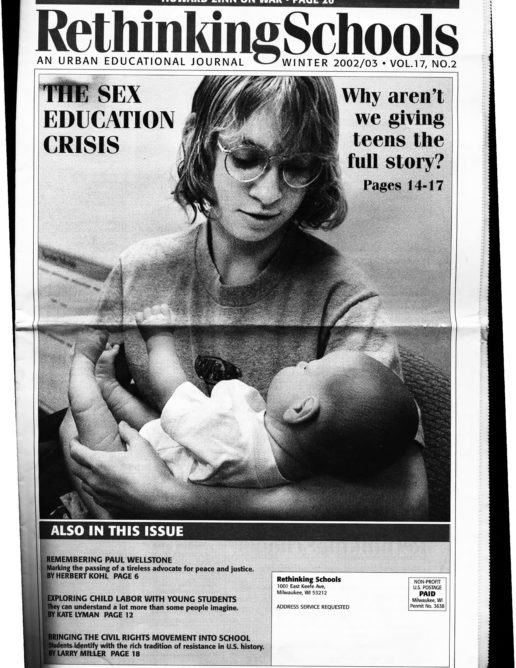Two Approaches To Sexuality Education
“So, what would make you decide to take a risk – drink that beer, smoke that doobie, drive without a seatbelt, have sex?” Paul Zettel, a health teacher at Milwaukee’s Riverside High School, asks his 34 tenth grade students. The students sit up straight. Hands wave in the air.
“To have fun or have an adventure,” answers one.
“To do what my friends were doing,” says another.
“To see what it was like,” volunteers a third.
Clearly, Zettel, has a lot of work to do.
Within a few weeks, Zettel will have moved beyond teaching decision- making skills to lessons on personal wellness, mental health, risky behaviors and sexuality. The sexuality unit includes information on relationships, human reproduction, teen pregnancy, contraception, abortion, and homosexuality. To be sure, he’ll encourage his students to abstain from sex – he describes the curriculum as “abstinence-based” – but he also covers contraception, sexual harassment and sexual assault, sexually transmitted diseases, and HIV.
Zettel is passionate about what he does and about the importance of comprehensive sexuality education. His one-semester class is based on Milwaukee Public Schools’ human growth and development curriculum. “If I don’t give them all the facts, they’re more likely to make unhealthy choices,” he says.
Meanwhile, Pat Kirby’s message, as she welcomes 30 seventh-grade girls to a Best Friends class at Lincoln Center Middle School of the Arts, isn’t all that different from Zettel’s. One of the first things her students are going to be learning, she tells them, is “to make good decisions.”
And when Kirby polls her students on why they’ve volunteered to be in Best Friends, their answers are as painfully revealing and every bit as honest as those of Zettel’s students:
“I don’t know.”
“To get out of class.”
“Because my friend is in it.”
“To get the necklace.”
Kirby, urging some of the girls to “rethink that answer,” goes on to explain what else they can expect from the program. “We’re going to be talking about what it means to be a best friend, how to respect yourselves and how to take responsibility for your behavior,” she says. “And about abstinence – saying ‘No’ to drugs, sex, alcohol, and violence.”
Kirby’s students are quiet and shy – she has to work hard to draw much of a response from them. That is, until they hear the word “sex,” which unleashes a chorus of little girl giggles.
But if Kirby starts out much like Zettel, with lessons on the importance of making good decisions, her scope is much more narrow. Girls who sign up for the program sign pledges vowing to abstain from sexual activity. And the only time Kirby mentions contraception is to talk about failure rates.
Best Friends (as well as its companion programs, Diamond Girls for high school girls and Best Men for adolescent boys) is a youth development program that focuses on the value of abstinence from sex, drugs, and alcohol. All three programs are run by the national Best Friends Foundation, which was founded in 1987 by Elayne Bennett, wife of former U.S. Secretary of Education William Bennett. In MPS, the programs are meant to be used as supplements to the district’s human growth and development curriculum. Participants attend monthly classes during the school day and are matched up with mentors who can act as positive role models. Peer support is a strong component of all three programs.
A total of 940 girls in fifth through 12th grades at 13 MPS schools and 550 boys in fifth grade through eighth grade at 10 schools are involved in the programs this year. According to district and state officials, funding comes from a combination of federal abstinenceonly funds and private grants.
Kyle Witty, who coordinates the Best Men program, said it aimed to boost boys’ self-respect and teach them to respect women. Witty said the program helped underscore the message that issues of teen sexuality should not be seen as solely the responsibility of girls. “Unfortunately, our society still has that ‘boys will be boys’ attitude,” he said. “But [sex] is just as much, if not more, the responsibility of boys.”
Although Best Friends has never been evaluated independently, officials claim that fewer than one percent of participants become pregnant and that 75 percent say they want to wait until marriage to have sex. The program was honored in 1997 as one of the nations most effective programs by the National Campaign to Prevent Teen Pregnancy.
“We do see progress,” said Kirby. “They grow up a lot and their attitudes change. We’re able to convince many that abstinence is their very best option A lot of them, I believe, are waiting.”
Yet, Kirby – an alcohol, drug abuse and HIV/AIDS counselor – said she hopes the girls in Best Friends were also learning about contraception. “They probably should know,” she said. “Some are bound to have intercourse and at least would be able to protect themselves.”
Bob Helmeniak, who oversees sex education for MPS, said the two approaches being used by Zettel and Kirby exemplify the range of sexuality education being offered in MPS. He said the district’s comprehensive human growth and development curriculum, adopted in 1982 and revised in 1995, is currently being revised again. “The curriculum is there,” said Helmeniak. “How the schools go about using it is up to them.”

